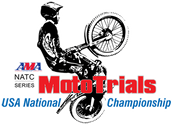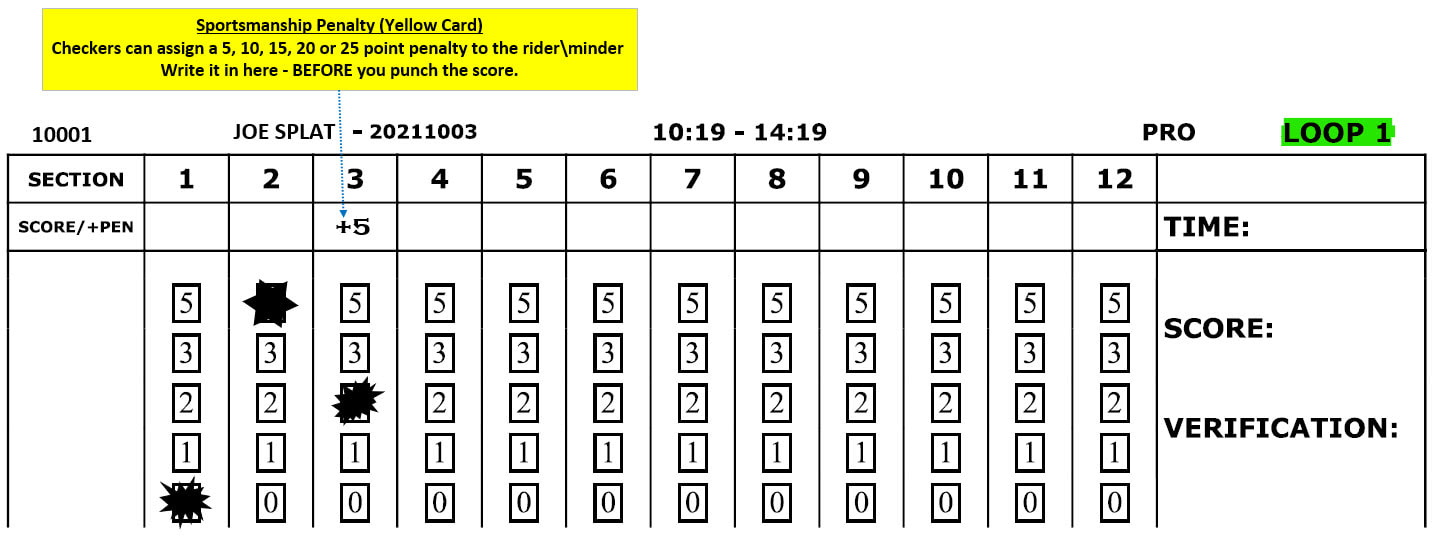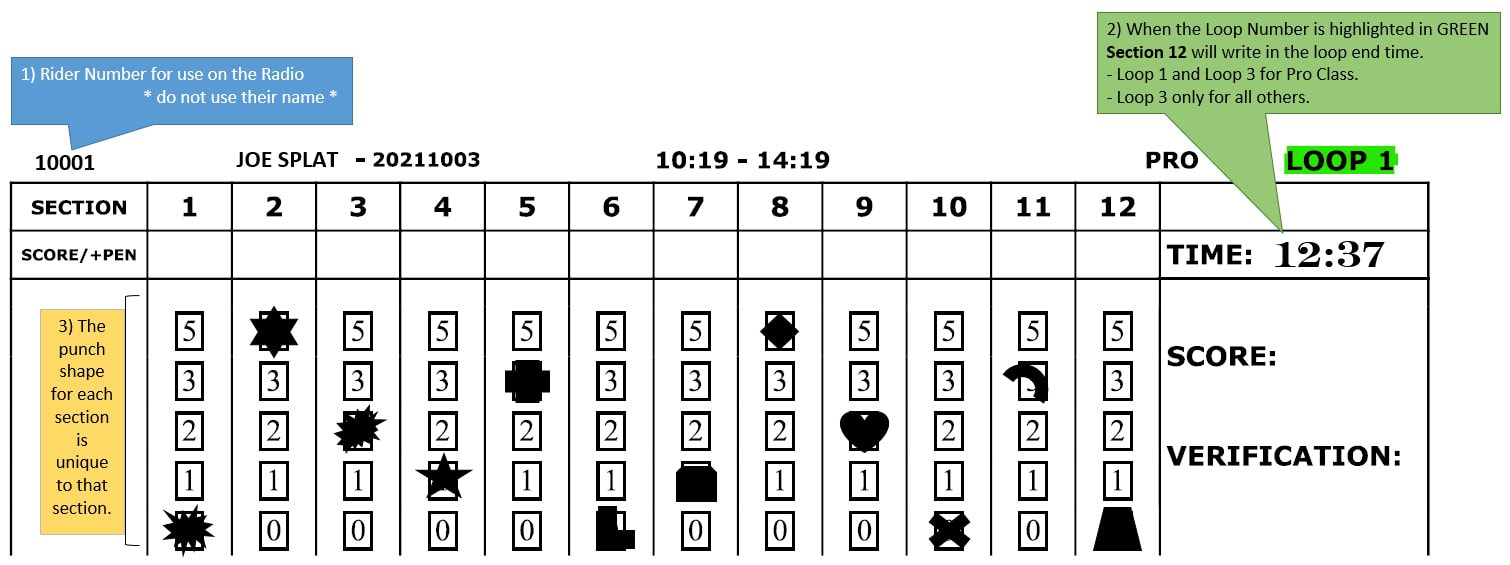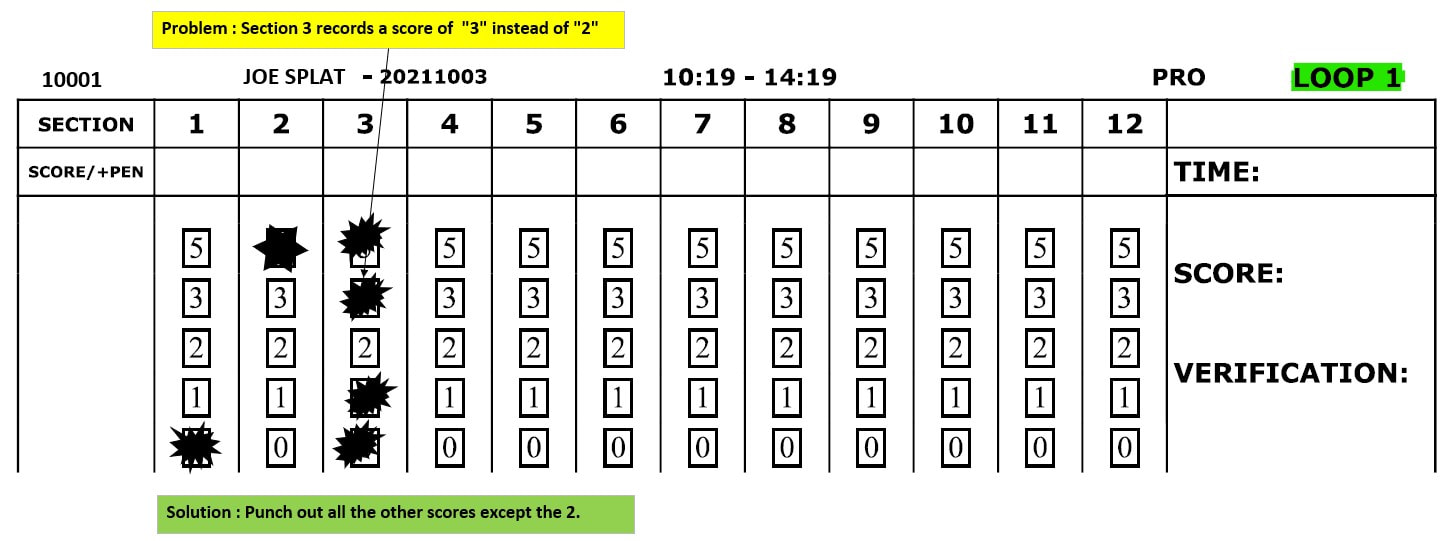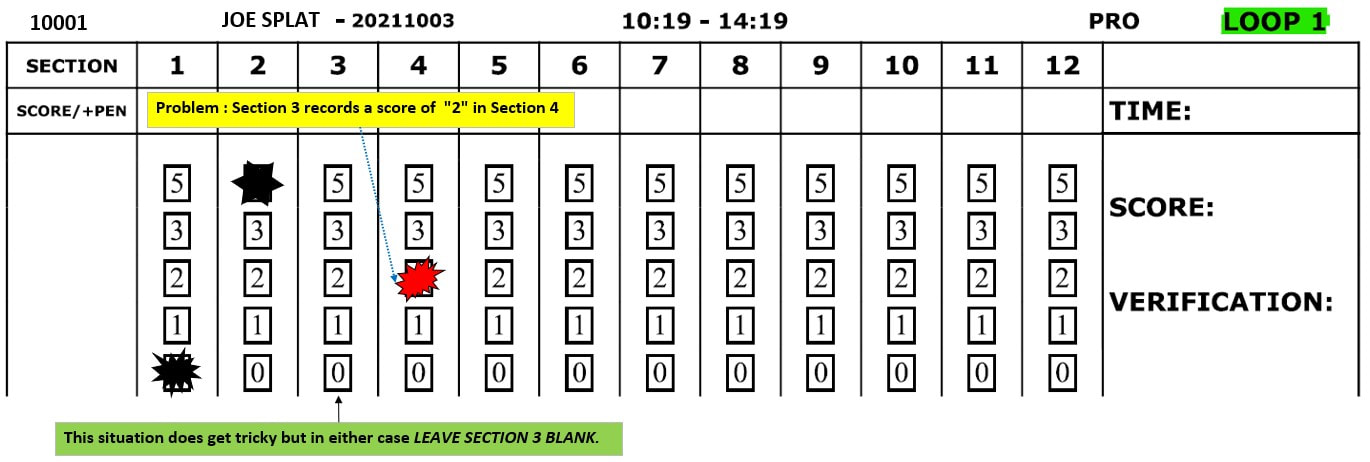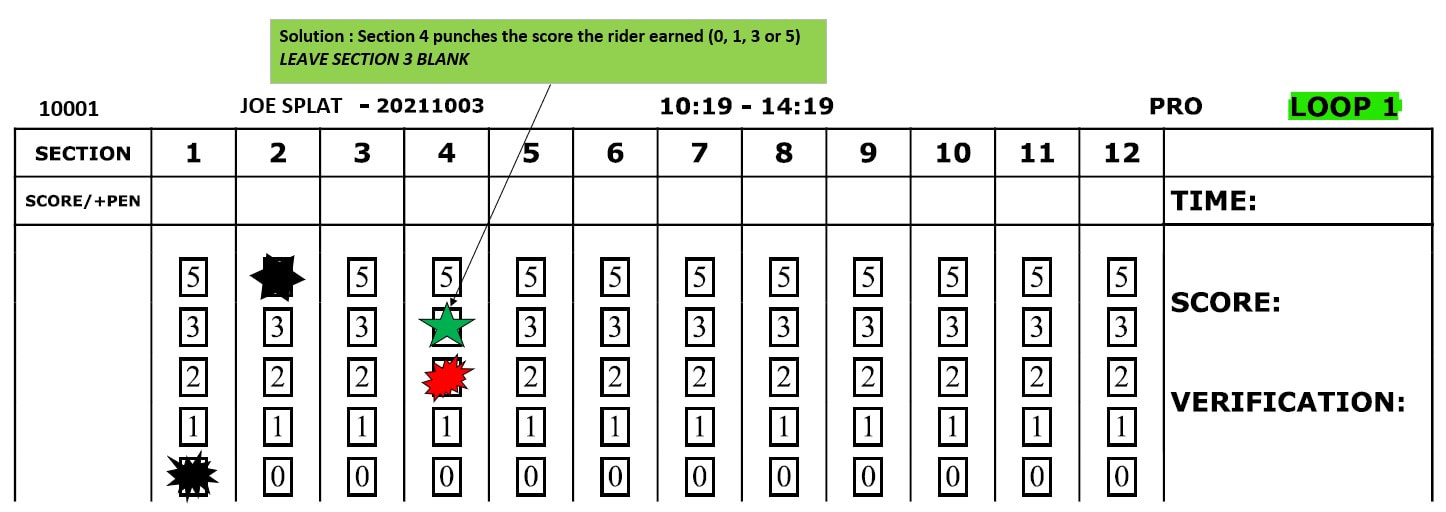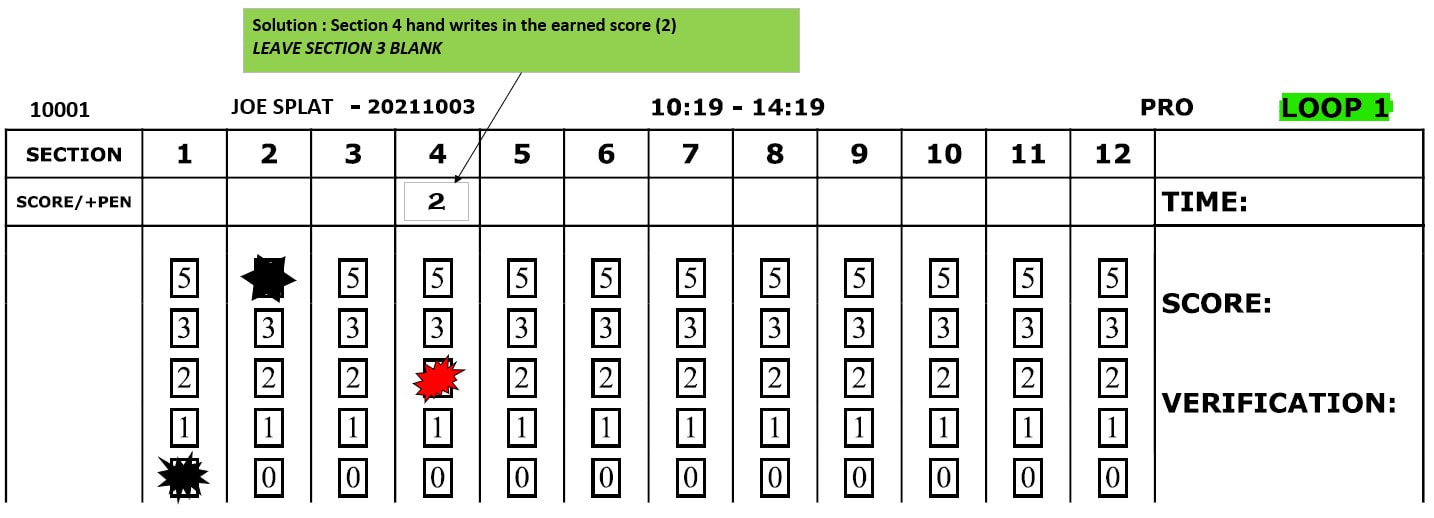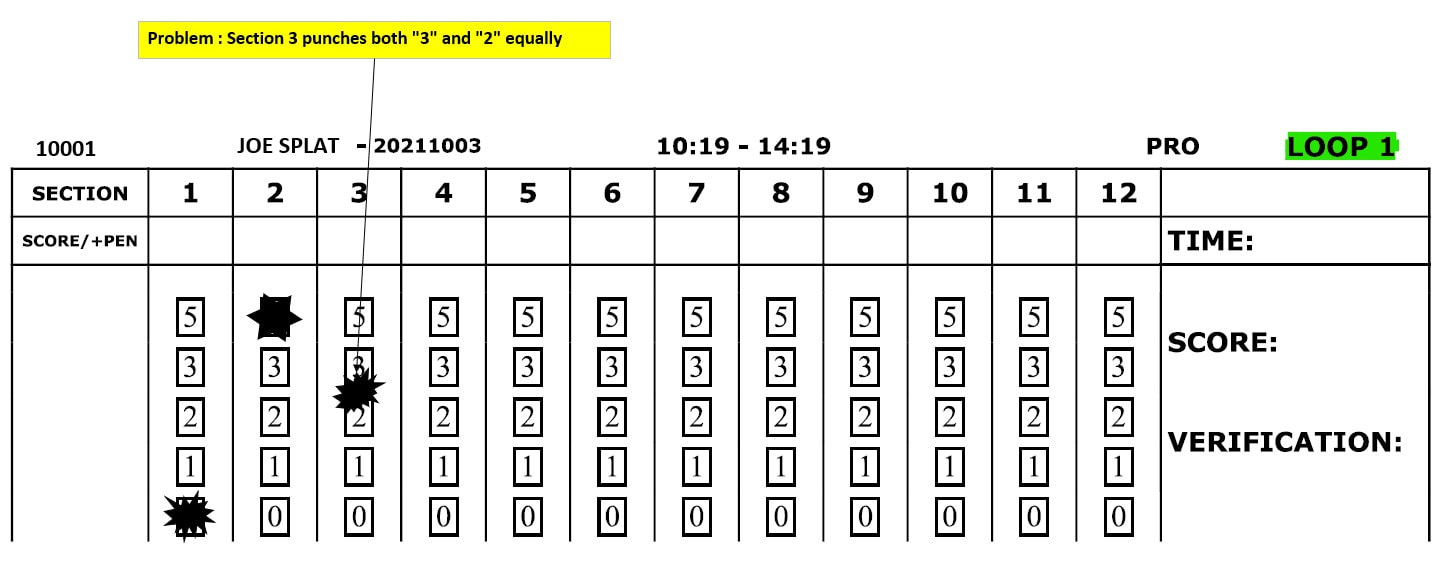The Art of Checking
The Checkers Guide combines the best information from the current rule book, the NATC training video, discussions that occur at the checkers meeting and best practices into a single document to help you prepare to check a National Mototrials event. Whether this is your 1st time or your 41st time there is always something new to learn or improve on so please please please review, prepare and ask questions if something isn't clear. This Checkers Guide is a living document and you can email us any feedback or suggestions for improvements by clicking here.
- Huge shout out to Charlie Rowlett (Plonkers Trials Club President Emeritus) whose original document "YOU ARE THE BOSS" provided the framework for this guide. NATC has borrowed and adapted his original creative work here with permission.
YOU ARE THE BOSS
The job of the Section Observer or "Checker" must be considered the most important element in the sport of Observed Trials. For evidence of this, simply turn to the name. After all, it’s not called "Section Trials", "Rider Trials" or even properly, "Motorcycle Trials". So why then do we see countless hours of rider practice and millions of dollars of machine development, but next to nothing in Observer recognition? The fact is, without these unsung heroes the sport could hardly exist. Similar to the umpires of baseball, the Section Observers call the shots on every play. The outcome of the competition rests confidently in your hands.
Appropriately, section observing should not be attempted with a half-hearted attitude. Based on the fact you are reading these guidelines indicates that you wish to strive beyond mediocrity. Contained herein we have set into print some important guidelines to assist you in doing the best possible job. They have been written in a simple bulletized format for quick reading and understanding. In many instances an illustration has been included for additional clarity. In certain areas, the "Observer’s Rule of Thumb" has been provided to give extra insight into a particular rule. Whether you are a first timer or a seasoned vet use this document to broaden your scoring knowledge and help you become a more effective Section Observer.
Thank You Thank you Thank You in advance for volunteering your talent, time and services in supporting our great sport.
Begin your journey by watching the following video which covers the rules and how to apply them in various scenarios. The subsequent text details the specific rules covered and has links back to the exact spot in the video if there are any questions. The final section of this guide covers the details of marking the scorecard for various scenarios (penalties, protests, punching errors and loop times) and closing the section.
2018 Version
Click here to download video for "offline" Vewing - DOWNLOAD
Do note that there are two items in the video that are incorrect and will be fixed in the next version:
- At 12:53 : The Rider removes their hand from the handlebar and uses their hand to reposition the motorcycle or perform mechanical adjustments to the motorcycle when footing while stationary. (7.B.4) Video Link Note that in this case the video is outdated. The rule has been changed and the rider can remove their hand from the handlebar to wipe sweat, adjust glasses or make other non-mechanical adjustments without incurring any penalty.
- At 13:51 : The handlebar touches the ground and the motorcycle is more than 45-degrees from vertical. (7.B.10) Several examples in the Video Link. Note that in this case the video is incorrect saying "less than 45 degrees from vertical" and it should be "more than 45 degrees from vertical"
The Observers Equipment
Video Link
The NATC will provide a backpack of equipment for each section that includes:
In addition, you should be prepared with:
Video Link
The NATC will provide a backpack of equipment for each section that includes:
- A pre-programmed 90 second countdown timer
- A whistle
- A preset radio for communicating with the scoring table should issues arise
- A uniquely shaped section punch
- A notepad and twos pens for noting any protests or other anomalies that might occur
- A rulebook
- The dreaded yellow card for issuing unsportsmanlike conduct penalties
- Section Repair Kit
- Trash Bag used to protect the backpack in case of rain
- Section 12 only will have a clock for recording the loop times. Pro loop times are recorded at the end of Loop 1 and Loop 3. Everyone else's loop time is recorded at the end of Loop 3.
In addition, you should be prepared with:
- sturdy shoes (waffle-soled hiking boots work well)
- suitable clothing for the range of weather expected
- hat
- sun screen
- bug spray
- lip balm
- umbrella (for sun or rain)
- stool or chair for those rare moments when you get to take a break
- food and drink
The Observers Mindset
From the moment you arrive at your designated section you need to acquire the mind-set that this is your turf. This means you are in control and responsible not only to know all aspects of your section, but to assume the duties of crowd control as well. Don’t be shy to advise riders or spectators to clear the section if they may interfere with the rider or your scoring duties.
Helpful Tips
Know your section - Video Link
With your fellow observers, walk each of the lines in the section just as the soon-to-arrive competitors will. Become familiar with the intended lines for each class and talk about the possible options and how to best score the section.
Try to anticipate problem areas and discuss observer positioning to get the best viewing angles possible. You may have to change positions depending on which line the rider is taking.
Insure all markers are securely in place. Consider taking pictures of marker placement as a reference in case they need to be reset.
Make sure there is both a left-side card and a right-side card creating a "gate". There are no "splits" (use of just one card as a marker) in National events. Report any issues to the trials master. Any issues must be fixed before the first rider arrives.
Note any questions for the trials master when they ride the loop to check that everything is in place.
There are at least three observers per section. Your team will need to decide who will fill which role:
- The timing observer, best to be "the loud one" as you will have to talk over the riders and yell at folks to "clear the section", yell "rider" etc.
- The observer captain, generally but not always the most experienced of the group and usually in charge of making most of the 'tough calls' as they typically have the best view of the entire section.
- The scoring observer, good eyes and a steady hand for accurate punching. Congenial, able to deal with the riders ups and downs and give them encouragement as they roll down the loop to the next one. No "chatty Cathy's" :-) , remember riders are on a time clock as well and any delays can affect the overall results.
The timing observer should practice using the whistle and the countdown timer before the riders arrive so you are ready to go and familiar with the equipment. If there is a problem with the countdown timer use a cell phone as a backup until a course marshal can bring a new one.
The observer captain should also be the radio operator since the other two already have their hands full. If calling in a medical emergency on the radio only use the riders number (located in the upper left hand corner of their card) and do not use the riders name or the number on their number plate.
The scoring observer should clearly say both the Section Number and the Score - "Section 2 - clean" when punching the score,
Section 12 may have a 4th person dedicated to writing down the loop end times.
Observers Rule of Thumb
In general, it is not an acceptable practice to alter the section as laid out by the set-up crew. However, in areas where rider safety is in question, it is advisable to consult the Trials Master.
Carefully select the best vantage point to observe the riders as they pass through your section.
Make sure the section is clear for the on-coming rider. Direct other riders as necessary who may be blocking the rider’s line or your clear view of the section.
Make eye contact with each rider as you signal them into the section. This is typically done by holding your closed fist above your head and either shouting, "Rider" or blowing a whistle.
Stay focused on the rider you are scoring and do not become distracted.
Be decisive with your calls and do not be influenced by the popularity of the rider or difficulty of the section. It is important to be consistent with your scoring.
Always indicate the number of points the rider has by displaying the appropriate number of fingers from your outstretched arm.
If not sure, give the rider the benefit of the doubt. Allow the rider to question your call, but do not permit the rider to "badger" you into a more favorable score. It is the observer who makes the final decision - after all - You Are The Boss.
Scoring Fundamentals
Competitors may inspect the section by foot at any time during the trial competition. In doing so, they should not hinder the progress of another competitor or obstruct the observer’s view to score another rider.
The section observer begins scoring the rider from the moment the front axle of the motorcycle passes through the section "Start" gates and concludes when the front axle passes through the section "End" gates.
The most common penalty points are when the rider touches a foot to the ground, hence the term "footing". However, penalty points must be assessed when the rider uses other parts of their body to aid in balance such as a knee, elbow or shoulder. Parts of the motorcycle, such as the handlebar may also be used to aid balance and should be counted as footing.
The only parts of the machine which may touch the terrain without penalty are: Tires; Footrests; Engine casings and their protection (skid plate).
No person may protest another rider's score. Only the rider can protest their own score. Video Link
Observers Rule of Thumb
If a rider incidentally brushes against a tree, rock or other terrain object with a shoulder, elbow, knee, handlebar, etc. and the contact does not noticeably aid in supporting the rider, it should not be considered as footing.
*** THE RULES ***
Note: the bold text below is the exact rule from the rule book and any additional supporting commentary is in (normal text). The numbers (#1) are to facilitate the Friday, Saturday and Sunday checker meetings as the meeting organizer(s) will step through each rule to see if there are any further questions or clarifications needed.
The Video Link entry jumps directly to the part of the video that covers the rule in case there are questions.
The penalty points covered below are only those which an observer can apply to a rider's scorecard. There are many other penalty points that can be assigned by the scoring table, sporting steward, trials marshal or other officials and those are outside the scope of this document.
Let's get to it...
Faults (Footing 1, 2 or 3 points)
The NATC training video covers many examples of scenarios where 1, 2 or 3 points can be earned for faulting. The maximum numbers of points for faulting is 3 points and riders are allowed to paddle their way through the section. Video Link
#1 : Footing: any contact providing support between any part of the Rider’s body or motorcycle (exceptions: tires, foot pegs, or skid plate) with the ground or an obstacle (tree, rock, etc.). Footing can occur either inside or outside the Section boundaries. For tires outside the boundary, refer to 7. B.15. Note that ‘toe dabs’ will be counted as footing. (7.A.1) Video Link : Toe Dab Video Link
Failure (5 Points)
A five is the highest possible score a rider can achieve in any given section. Video Link
"Fives" can be awarded in several ways. For the purposes of these guidelines, we have classified them in two broad categories:
- Navigating the section boundaries and markers
- Involving events that occur within the section boundaries
Navigating the section boundaries and markers.
#5 : If the Rider chooses to not attempt a Section, the Rider must report to the Observer with the Rider’s score card to receive a "5" for that Section. (7.C.1)
#6 : Failure to wear a visible and functional drivetrain disable device that stops power delivery as soon as the rider separates from the motorcycle. (7.B.17) Video Link The timing observer should check that the rider has their tether attached before they enter the section.
#7 : The Rider begins a Section attempt without the Observer’s acknowledgment. The Observer shall show a raised, balled fist and announce “Rider” in a loud voice to authorize a Rider to start riding the Section. (7.B.8) Video Link
#8 : The front axle does not pass through the Start and End gates, and all other gates for the class. (7.B.16)
#12 : The Rider passes, in either direction, through a gate of another class - that is, breaking the plane of a gate. (7.B.14) Video Link
#13 : Either tire passes on the out-of-bounds side of the Section boundary with the tire on the ground. In the case of running over a taped boundary, for a Failure to occur there must be ground visible between the tape and the tire and the tire must be on the ground on the out-of-bounds side of the tape. It is permitted to float one wheel over an exterior Section boundary, but not both tires. Jumping the motorcycle so that it travels outside of a boundary is a Failure. (7.B.15) Video Link
#14 : Despite your best efforts to keep the section clear, there may be the occasion when another rider or spectator obstructs the path of a competing rider.
Obstruction is deemed to have occurred when a Rider, attempting a Section is prevented from completing a bona fide attempt due to some unauthorized obstruction. If a Rider claims obstruction, the Section Observer’s decision as to whether a re-ride is permitted is final. Should a re-ride be granted, the Section shall be ridden from the start of the section with the same time limit as the original attempt but will be observed from the point of obstruction onward. Any points lost prior to the point of the obstruction of the original attempt will stand. (9.1) Video Link
The resulting score from this second attempt will be the final score, even if it is higher than the original ride.
#15 : The Rider does not complete a Section within the 90 seconds allowed. (7.B.5) Scoring shall start when the motorcycle’s front axle passes between the Start markers and stop when the front axle passes between the End markers. The Observer will use a stopwatch and whistle to administer the Rider’s 90-second time limit to ride the Section. The Observer will blow the whistle and start the clock when the front axle passes through the start gate. The Observer will blow the whistle a final time at 90 seconds if the Rider has not exited the Section, or at any time the Rider records a Failure (5 points).
Events that occur within the Section Boundaries or Markers.
#16 : The Rider or Minder changes the condition of a Section while not riding the Section. (See 7.C.12 (Yellow Card Rule) & 4.11) (7.B.7)
#17 : The Rider receives deliberate outside assistance. (7.B.6) Several examples of the minder providing direct assistance to the rider in the Video Link
#18 : Any displacement, breaking, or knocking down of markers by direct contact of the motorcycle or Rider requiring that the marker be reset to its original position is a Failure. Touching a boundary is not a Failure. (7.B.2) Video Link In the event of a marker being displaced, it is the observers job to fix the marker.
#19 : The motorcycle does a complete loop in a Section - crossing both its' own tracks with both wheels. (7.B.11) Video Link
#21 : The handlebar touches the ground and the motorcycle is more than 45-degrees from vertical. (7.B.10) Several examples in the Video Link. Note that in this case the video is incorrect saying "less than 45 degrees from vertical" and it should be "more than 45 degrees from vertical"
#22 : The Rider removes their hand from the handlebar and uses their hand to reposition the motorcycle or perform mechanical adjustments to the motorcycle when footing while stationary. (7.B.4) Video Link Note that in this case the video is outdated. The rule has been changed and the rider can remove their hand from the handlebar to wipe sweat, adjust glasses or make other non-mechanical adjustments without incurring any penalty.
#23 : The Rider dismounts from the motorcycle and has both feet on the ground on the same side of the motorcycle, or if both the Rider’s legs are behind the motorcycle’s rear tire with both feet on the ground. (7.B.3) Video Link
#24 : The engine stops while footing or while any other part of the motorcycle, except for the tires, is used for support, without forward motion. The motorcycle must be moving forward while footing with a dead engine to avoid a 5-point score. (7.B.9) Video Link
#25 : A rider should not unduly detain you from your scoring duties by pleading their dissatisfaction with your call. Should a rider become belligerent, try to remain calm and advise them that they have the option to file a formal protest. If the rider continues to argue, advise them that you are prepared to assess additional penalty points for their behavior and will take the matter up with the Course Marshall.
It is the Rider’s responsibility to acknowledge the score given and verify the Rider’s scorecard is punched correctly at each Section and time recorded correctly when required. Verification must take place immediately upon completion of the attempt. Disagreement with the Observer must be noted and settled, if possible, while the situation is fresh in everyone’s mind, without inconveniencing or delaying other Riders. Scoring protests will not be heard if the Observer was not made aware of the conflict immediately after the Section attempt. (9.2)
#26 : Only the greatest penalty, as defined above, shall be counted for the Section. However, the following points may be added as listed in 7.C.1-15. (7.B.19)
Unsportsmanlike Conduct \ Yellow Card Penalty Points
From time to time riders get "caught-up" in the pressure of the competition and behave in an unsportsmanlike manner. This poor behavior should not be tolerated, and if not immediately controlled, can be addressed with additional penalty points.
The general rule of thumb here is to issue the rider\minder a firm verbal warning before showing them the yellow card. This warning will resolve 99% of the issues. If rider/minder continues their conduct then show them the yellow card and issue the penalty points.
#27 : Unsportsmanlike conduct, or offensive behavior or language by a Rider or Minder, will result in a penalty of 5 to 25 (or 100) points, or disqualification of the Rider and Minder, at the discretion of the referee. The 5- to-25-point penalty can be given at the sole discretion of any Observer or course official. The 5-to-25-point penalty can be punched on the Rider’s scorecard in the five boxes provided. A written report must be filed with the Referee for the 100-point infraction. Repeated offenses may lead to further sanctions—as per AMA rule Chapter 4.4, item 3. (7.C.7) Video Link
#28 : YELLOW CARD RULE : Any Rider or Rider’s Minder who refuses to obey the instructions of an Observer, or who behaves in an unsportsmanlike manner, shall be shown the Yellow Card. (See 7.b.7, 9.5 and 7.C.7). The penalty for being shown the Yellow Card is 5 points for the first offense, 5 points for the second offense, and exclusion for the third offense occurring during a Trial. Penalty points are in addition to the points accumulated during the Rider’s Section attempt. (7.C.12) Video Link
#27 : Unsportsmanlike conduct, or offensive behavior or language by a Rider or Minder, will result in a penalty of 5 to 25 (or 100) points, or disqualification of the Rider and Minder, at the discretion of the referee. The 5- to-25-point penalty can be given at the sole discretion of any Observer or course official. The 5-to-25-point penalty can be punched on the Rider’s scorecard in the five boxes provided. A written report must be filed with the Referee for the 100-point infraction. Repeated offenses may lead to further sanctions—as per AMA rule Chapter 4.4, item 3. (7.C.7) Video Link
#28 : YELLOW CARD RULE : Any Rider or Rider’s Minder who refuses to obey the instructions of an Observer, or who behaves in an unsportsmanlike manner, shall be shown the Yellow Card. (See 7.b.7, 9.5 and 7.C.7). The penalty for being shown the Yellow Card is 5 points for the first offense, 5 points for the second offense, and exclusion for the third offense occurring during a Trial. Penalty points are in addition to the points accumulated during the Rider’s Section attempt. (7.C.12) Video Link
Unsportsmanlike Conduct includes the following:
#29 : A helmet that meets AMA or FIM approval is required to be worn by the rider when the rider is in a section as well as whenever operating a motorcycle at a Trials site. (2.F.1) This includes both walking the section and riding the section.
#29 : A helmet that meets AMA or FIM approval is required to be worn by the rider when the rider is in a section as well as whenever operating a motorcycle at a Trials site. (2.F.1) This includes both walking the section and riding the section.
#30 : Approved motorcycle-type helmets (as listed in item 2.F.1) are required to be worn by the Minders (and assisting minders) while the Minder is in the Section as well as whenever the minder is operating a motorcycle at a Trials site. (4.8)
#31 : A Minder must abide by all applicable rules. Minders are only allowed in the Sections when their Riders are attempting a Section or as otherwise allowed by the Observer. Any penalty assigned by an observer to a minder will be added to their riders score. (4.7)
#32 : A Minder is not permitted to move any objects within the Sections, and cannot provide a foot berm, foot kicker, or any other direct means of helping within a Section, and cannot reinforce an obstacle within the Section. (See 7.C.12) (4.11)
#33 : A Minder is not permitted to influence Observers or protest a call. (See 7.C.12) and (9.5) (4.12)
#34 : A Rider waiting in line to enter a Section must not leave the Rider’s motorcycle. If the Rider does, the Rider must go to the end of the line. Refusal to comply may be considered unsportsmanlike conduct. (See 7.C.7.) (7.C.4) Video Link
#35 : Any Section ridden more than once per loop will receive 10 (penalty) points, in addition to the first-attempt score. (See 7.C.7) (7.C.5)
#36 : Exceeding any posted speed limit is a 5-point penalty (for each offense) before, during and after the Trial (See 7.C.7) (7.C.8)
#37 : Violation of these supplemental riding rules by a Rider or Minder will result in a penalty ranging from 5 points to exclusion from the Trial. If a Rider refuses to present the Rider’s card to the Observer for punching the appropriate score for the additional penalty, or leaves the scene of the infraction, the Observer shall document the circumstance and report it to the Trials Master. Wherever possible, the Observer must punch the additional penalty before punching the riding score. The Protest Jury will assess the appropriate penalty. (See 7.C.7 & 7.C.12). (7.C.13)
#38 : A Rider cutting the course or going backwards on the Course may be disqualified at the discretion of the Referee. (7.C.14)
Marking Scorecards
3 Things to know about your scorecards:
- Use the rider's number on the radio and not their name or the number on their number plate
- When the loop number is highlighted, Section 12 will write in the Loop time. Write-in just the Hour and Minute (no seconds) Loop 1 and 3 are timed for the Pros. Accuracy is important since a) the pros are rewarded for the fastest Loop 1 time and b) the Loop 3 time is used as a tie-breaker. Video Link
- Each section punch is unique to help in identifying punching mistakes
Marking A Rider Protest
Note: only the rider, not their minder or another rider, can protest their score.
Write the Letter "P" above the score. In this scenario the rider is protesting a 5 on Section 2.
** Very important - be sure to write down the rider's number (10001) and the details of the protest in your notebook **
Write the Letter "P" above the score. In this scenario the rider is protesting a 5 on Section 2.
** Very important - be sure to write down the rider's number (10001) and the details of the protest in your notebook **
Bonus Info - Protest Process Steps:
- Rider must file their protest with the checker at the time of disagreement (i.e. they can't file it after the fact at the scorer's table)
- Checker writes the rider number and details of the issue in their section notebook.
- At the completion of the loop the rider turns in their card.
- The rider then writes down their version of the issue and gives it to the scoring table.
- The scoring table will contact the sporting steward to review the protest.
- The sporting steward will ride out to the section in question.
- After discussion with the checkers a decision is made.
- The sporting steward will tell the scoring table how to score the card.
What if - Checker Punches The Wrong Section
There are two options here for the checker in Section 4:
Option 1 : The rider scores something besides what is already punched (ex: 0, 1, 3 or 5) in Section 4 - then punch the score they earned.
Option 2 : The rider scores the same as what is already punched (2) in section 4 - then hand write their score in the space provided.
What if - The Punch Crosses Two Scores
Options, Options, Options:
- If you do nothing, the scoring table will give the benefit of the doubt to the rider and will score the lower score (2).
- Make a second punch of the earned score so it is more obvious which is the correct score. Don't punch more than twice or it is too hard to ensure the correct section punch was used.
- Write the score in the space provided.
Closing Your Section
So it has been a long day and you've observed some 250 to 350 attempts by the best riders in the country giving it their all. Things are wrapping up and you haven't seen any riders come through for a while. You are ready to pack up and head back to the pits for a refreshing beverage and dinner.
But not quite so fast - the scoring table and the sporting steward are working together to make absolutely sure the last rider has been through your section. You can only close your section when you get verbal approval either in-person from the sweep crew or over the radio.
Timing wise each rider typically has up to 7 hours (or 7 1/2 in some cases) to complete the course. If there are 100 riders that day then the last rider started at 10:40 am meaning you could be on duty as late as 5:40 pm (or 6:10 pm)
Tracking the last riders can be a challenge especially in the case of mechanical issues late in the event. The priority of the riders comes first since they've paid to ride for up to 7 (or 7 1\2) hours so the organizers ask for additional patience on your part. Far better to close the section a few minutes late than to close up too early and short change the riders.
Once the section is closed, return to the pit area and turn in your section's scoring backpack and all the equipment to the scoring table, Now you can relax and rest easy knowing you helped create a great event experience for all the riders.
But not quite so fast - the scoring table and the sporting steward are working together to make absolutely sure the last rider has been through your section. You can only close your section when you get verbal approval either in-person from the sweep crew or over the radio.
Timing wise each rider typically has up to 7 hours (or 7 1/2 in some cases) to complete the course. If there are 100 riders that day then the last rider started at 10:40 am meaning you could be on duty as late as 5:40 pm (or 6:10 pm)
Tracking the last riders can be a challenge especially in the case of mechanical issues late in the event. The priority of the riders comes first since they've paid to ride for up to 7 (or 7 1\2) hours so the organizers ask for additional patience on your part. Far better to close the section a few minutes late than to close up too early and short change the riders.
Once the section is closed, return to the pit area and turn in your section's scoring backpack and all the equipment to the scoring table, Now you can relax and rest easy knowing you helped create a great event experience for all the riders.
Thank you again for your talent, time and effort - without you there is no event.
Version 1.0 - Feb 14, 2022 - original document
Version 1.01 - Feb 21, 2022 - added clarification to #29 "This includes both walking the section and riding the section."
Version 1.02 - Feb 25, 2022 - fixed some minor contextual issues in the scorecard images
Version 1.03 - Nov 23, 2022 - 2023 rules update, minor wording changes
Version 1.01 - Feb 21, 2022 - added clarification to #29 "This includes both walking the section and riding the section."
Version 1.02 - Feb 25, 2022 - fixed some minor contextual issues in the scorecard images
Version 1.03 - Nov 23, 2022 - 2023 rules update, minor wording changes
©
MotoTrials USA Championship












